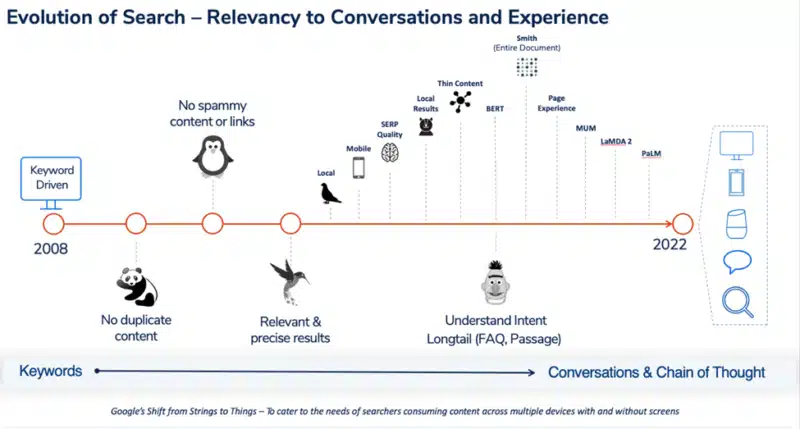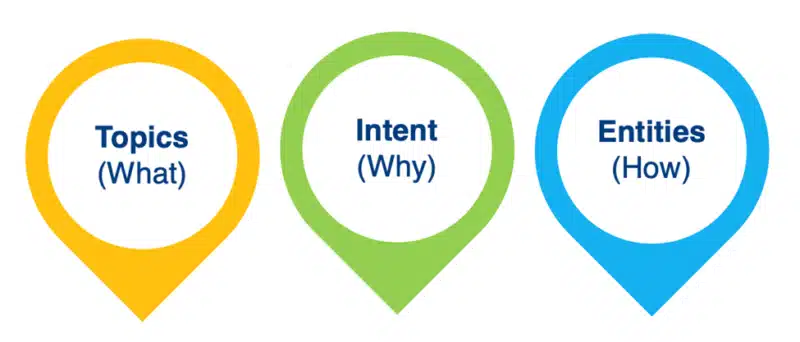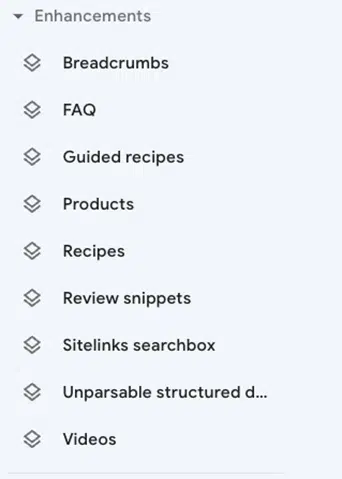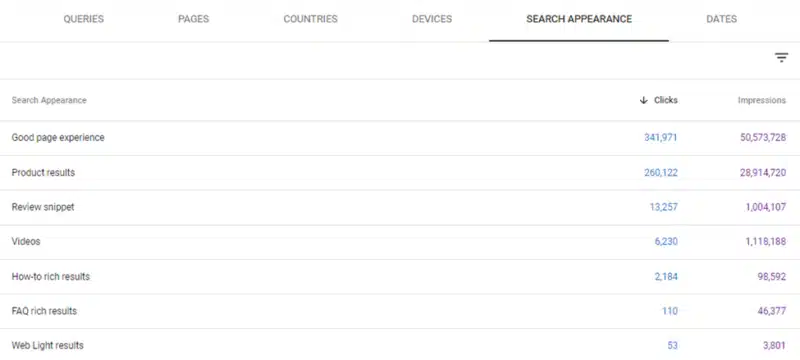Why entity search is your competitive advantage
Here's how to leverage entity search and deploy a winning strategy across the organization.
Entity search has become a competitive advantage for businesses and brands.
With Google opening its topics API and releasing the most comprehensive deep learning algorithms, such as PaLM, LaMDA2 and MUM, it’s critical to understand the semantic web and how to create and operationalize entity SEO.
This article will start our exploration of the what, why and how of leveraging entity search. (There is much more to come in my future Search Engine Land articles.)
What is entity search and why is it critical?
Before diving deeper into entity SEO or semantic SEO, let’s start with what problems search engines are trying to solve and how entities help solve these problems.
Simply put, search engines are trying to provide the best and most comprehensive answers to every search query across all devices.

However, the way we search has evolved.
A few years back, searching meant typing keywords into a search engine. Today, 40-50% of searches are conversational from various devices, such as smartphones, Google Home, Alexa, etc.
A major challenge for search engines is understanding the context and intent behind the user query. Search algorithms that previously matched content with keywords are inadequate to process and understand queries that are often sentences and paragraphs and match them with the most relevant result.
A search engine can only cater to this changing search behavior by understanding relationships between words without ambiguity.
What are entities and entity search?
An entity could be a person’s name, place, object, event, concept or numerical expression that a search engine can understand without ambiguity, regardless of language.
For example, let’s look at a query like, “what is the cheapest price for a hotel in the San Francisco Bay Area?”
How many ways can that question be asked? How would it appear in different languages? How can search engines understand that all those permutations and combinations of queries mean the same thing?
In the example above, search engines can understand the highlighted text:
- What: a concept – a question qualifier
- Cheapest: numerical expression – lowest cost
- Price: numerical expression
- Hotel: organization
- San Francisco: location
- Bay Area: location
By connecting these entities, search engines can understand both the query and the intent behind the query.
Once the query and the intent are understood, search engines try and find relevant information around “entities” in the query.
Search engines use various sources – the Knowledge Graph, citations, Wikipedia, reviews and various digital content – to provide the most accurate results.
The process of retrieving information by scanning all structured and unstructured content and using AI to provide the most relevant results is called entity/semantic search.
Traditional SEO versus semantic SEO – the difference
In traditional SEO, pages are ranked based on information retrieval scores using relevance, authority, and backlinks from other popular sites.
Semantic SEO focuses more on providing the most comprehensive information for user queries using entities, facts associated with those entities, associated attributes, and questions related to that fact.
With entity SEO, the focus is on making it easy for searchers to get the answers they want and the brands that provide the most comprehensive topical information satisfying searcher query intent.
How does entity optimization work?

Simply put, entity optimization brings three concepts together:
- What: the central topic of the query and what the searcher expects in the content when they search for that topic. It does sound similar to keywords, right? If you recall the example above, how many different ways can a question be asked in different languages and with cultural nuances? All those different queries are distinct keywords, but they are just one topic since they mean the same thing. Ensuring your content is the most comprehensive source of information on the topic by covering as many related topics as relevant to the searcher helps close topical gaps and address your audience’s needs.
- Why: The intent behind the query. Are they seeking information? Are they considering and evaluating options? Are they looking to navigate or seeking directions? Are they looking to transact and make a decision? Ideally, your content should cater to every need of your audience across their buying journey. Using a combination of what and why will help you identify all the possible entities relevant to your business. You can then create a content strategy around those topics and inter-connect them, building relationships between these entities.
- How: How your content is delivered is just as important. If your audience expects a video and you deliver text, it may not have the desired impact. Video, images, headings, bulleted and numbered lists, hours of operation, question and answer, recipe and calories (if you are a food business), the list goes on. These are various entities that we put together to create the most holistic semantic SEO strategy. Therefore, page/content layout becomes a critical part of a semantic search strategy.
These content elements can be marked up with structured data to help search engines understand the context and relationships between the content elements and the entities in your content.
Why semantic SEO/entity SEO gives you a competitive advantage
Clearly, semantic SEO is critical for businesses. Here’s why to adopt this strategy.
Search algorithms favor semantic search
SEOs in the past focused on link building and utilizing keywords to help search engines find the information. Search algorithms have surpassed keywords and determine the context and intent behind queries by understanding relationships between entities.
Optimizing keywords will help to some extent. Still, the most sustainable way to succeed is to optimize entities in your content and adopt an entity-first or semantic approach to SEO.
- Entities help provide the most comprehensive topical information and relevant SERPs. When page structure is optimized for entities/topics, the page’s focus is to provide the most comprehensive information about the topic, including text, FAQ images, videos, bulleted lists and everything else that entity/topic is associated with. SERP results referencing these topical pages are most relevant across all types of searches, including voice, web, images, video, etc.
- More areas to rank in SERPS: Google Discovery and Google Trends also appear in results based on entities. Google Discovery helps build layers of relevant entities.
- Optimizing content around semantic search or entities often yields more longer-term growth: Chasing keywords may give growth momentarily, but you must revisit and revise the content to keep the results.
- Higher impressions, engagement and traffic value: Content optimized for semantic search leads to higher impressions, more engagement, more rich results and much better-quality traffic.
- SERPs with rich results also provide traffic that engages downstream and converts better: This is because the media type is directly relevant, and they bring the users closer to their desired answer.
Position zero
Marketers sometimes worry that providing rich results, like in the Quick Answer/Featured Snippet listing, People Also Ask or a How-to, gives the user the information in the SERP without them clicking on the listing and driving visitors to the website.
While this is true, the benefits of appearing high up in the SERP outweigh the perceived detriment of users who do not click.
This is especially true when the listing would otherwise have been below the fold lower down on the search results page.
Entity optimization can also guide you when optimizing the content and rich results to maximize CTR from the SERP.
Milestone Inc. research on rich media frequencies in SERPs across over 500 websites

Milestone’s click curve research shows that appearing in rich results listings leads to higher engagement. On average, rich result listings get 41% higher engagement in terms of clicks than standard text SERPs without rich results.
Which entities should you focus on?
The easy answer is any entity that relates to the content of your business, with two categories being the most important.
The first is any entity that can help reduce ambiguity, such as business type, location, product details, and contact elements. To identify the right entities related to your business, you should review the schema.org classification for your business.

The second category is those elements where Google provides insights and demonstrates the structure of the business in the Search Console under Enhancements and Search Appearance.
Your website should have all these entities where relevant to ensure the topic/structure of the website is well understood.

Why understanding what is recognized and classified by Google and Schema.org is critical
Establishing a comprehensive understanding of what is recognized by Google and schema.org will help you come up with the right site and page structure.
Every business may not have a recipe; however, videos, FAQs, sitelinks and breadcrumb navigation are key elements that should be part of the content strategy for the website.
This shows the benefit of a well-structured page in SERP appearances and search impressions:

Entity-first SEO
Entity SEO is more topical and contextual and often includes rich media to help you position your content as the best answer for any query.
Adopting an entity-first approach can:
- Give your brand a competitive advantage in search.
- Future proof your content and digital asset creation strategy.
- Give your brand a competitive edge.
Contributing authors are invited to create content for Search Engine Land and are chosen for their expertise and contribution to the search community. Our contributors work under the oversight of the editorial staff and contributions are checked for quality and relevance to our readers. The opinions they express are their own.
Related stories